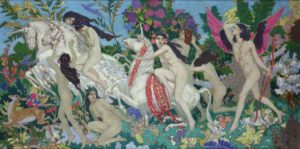Nowadays, when people think of unicorns, they think of them in the context of children, like little kids playing with unicorn dolls or watching My Little Pony. But a museum in the Scottish city of Perth is ready to tell the unicorn’s story more three-dimensionally. The Perth Museum, about an hour’s drive north of Edinburgh, will host an exhibition featuring art, artifacts, and texts to explore the cultural history of the unicorn. It seems appropriate that a Scottish museum would take on this task since it is Scotland’s national animal.
The Perth Museum plans on looking at how humanity has imagined and used the unicorn “from Pliny to Pride”. This fictional animal first appeared in ancient times, with some archaeologists identifying one-horned bovine and equine creatures on Bronze Age Indian decorative pieces. However, the first time a unicorn definitively appears is in ancient Greek texts on natural history. The fifth-century BCE physician Ctesias wrote the book Indica, detailing the flora and fauna of the Indian subcontinent based on Persian sources. In it, he describes a kind of donkey with a single two-foot-long horn. However, ancient Greek texts regarding the animals of far-off places are often not the most trustworthy. In his Histories, Herodotus described India as the home of packs of ants the size of foxes, while dog-headed men live in Libya.
In medieval European art, the unicorn became a common symbol. If you ever go to the Cloisters Museum in upper Manhattan, you will see countless tapestries featuring the fantasy creature. They are typically depicted in captivity or as the target of a hunt, often meant to draw parallels to Christ’s Passion. The parallels continue in that European folklore dictates that virgin women are the only ones who can tame a unicorn. In Scotland, the unicorn was adopted as a royal symbol in the early fifteenth century during the reign of the Scottish king James I. The unicorn became incorporated into the Scottish royal arms and even appeared on Scottish currency in the fifteenth and sixteenth centuries. In 1707, when an act of parliament merged the Kingdoms of England and Scotland to create the Kingdom of Great Britain, the new coat of arms featured a shield with the national symbols of England, Scotland, and Ireland, along with a crowned lion supporting one side and a chained unicorn supporting the other.
The Perth Museum’s exhibition, Unicorn, also plans to show how people tried to bring the fictional animal to life. Several pieces will be on loan from the Victoria & Albert Museum made from narwhal tusk, which, during the Middle Ages and into the early modern period, was often passed off as the horn of the unicorn. Whether carved with a decorative pattern or made into jewelry, these tusks were incredibly valuable, with Queen Elizabeth I paying as much as £4 million in today’s money for a complete tusk. But the exhibition also plans on featuring more modern depictions of unicorns. They have become incorporated into modern fantasy art and literature. On loan from the Dundee Art Gallery, John Duncan’s 1920 painting The Unicorns shows a group of nude female figures fleeing on the titular creatures from a winged male carrying a bow, meant to represent the god of love. Furthermore, the museum curators plan on telling the story of the unicorn as an LGBT symbol. The rainbow is one of the most ubiquitous symbols of LGBT and queer pride, leading the unicorn to become a symbol as well. The rainbow and the unicorn have been inextricably linked for centuries, so the connection is not too difficult to see. Furthermore, the unicorn is also a symbol of magic, elusiveness, and individuality.
Unicorn at the Perth Museum opens on March 30th and will run until September 22nd.

